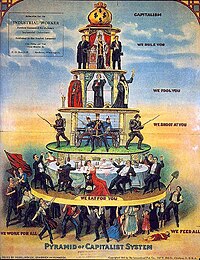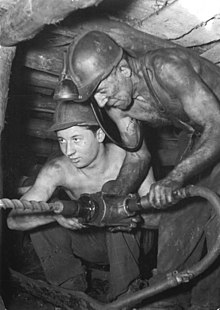Working class

The word working class is primarily used today as a term used in Marxism , which is often used synonymously with “ proletariat ” (for more information, see Competing terms for the term “proletariat” ). The term goes back to the industrial revolution , but its definition is controversial today. Members of the working class are not automatically to be equated with workers in the sense of predominantly physical workers.
Definitions
However, some Marxists and Marxism scholars take the term wider. According to Hal Draper , the industrial proletariat forms the core of the working class, followed by the non-industrial proletariat, i.e. the wage workers in the field of services and agriculture . According to Draper, wage workers who do not belong to the proletariat are wage workers in areas where no added value is created in the Marxist sense , for example in the state sector .
Finally, Draper also counts working class workers who are not wage workers. These would be e.g. B. family members helping out in agriculture, small self-employed craftsmen, farmers, small self-employed persons such as shopkeepers and the like (i.e. the traditional petty bourgeoisie ).
The working class today

While the factory workers used to be understood as the "working class" , the current meaning of the term is controversial. The proportion of industrial workers in the workforce reached a peak in the course of the so-called Second Industrial Revolution in the 1960s and has been falling continuously since then. The number of workers in the German economy fell from almost 40 percent of the workforce at the beginning of the 1990s to around 25 percent in 2017. "A working class as a political subject has long since ceased to exist," wrote Hans-Ulrich Jörges .
Workers and workers
If one takes the persons designated in the official statistics as employees (which includes “workers” and “employees”, including employed managers ) as a statistical substitute for the size of the working class, then the proportion of employees (a term that was used as early as the 19th . Century was coined as a counterpart to "employer") in some industrialized countries in the period from 1980 to 2008 increased overall. The employed are the “employees” and the “self-employed and the helping family members” (the latter are therefore not just “capitalists”). However, this view is controversial because it also means that highly paid employees count as employees. Conversely, there are many self-employed low-income workers.
Informal working class
The informal working class ( English working informal class ) is a mainly by Mike Davis coined sociological term for a class of mainly young than one billion urban people who are formally in any way with the world economy associated with a mainly slums to survive try. According to Davis, this class no longer corresponds to the socio- theoretical concepts of a class , as developed by Karl Marx , Max Weber or the theory of modernization . After that, this class developed worldwide from the 1960s, especially in the southern hemisphere. In contrast to previous notions of a class of the lumpen proletariat or the notions of a “slum of hope” from the 1920s and 1930s, the members of this class are hardly given any chance of attaining formal economic structures.
The term "working class" in the Soviet Zone / GDR (1945–1990)
The term “working class” was frequently used in the Soviet Occupation Zone (SBZ) from 1945 and in the GDR from 1949 to 1990. He was part of a worldview based on Marxism-Leninism , on which the SED, as the GDR state party, based its purpose and claim to leadership.
The area of the later GDR was occupied by Soviet troops ( Red Army ) in 1945 and declared an SBZ. The Soviet occupying power (SMAD) first enforced the merger of the KPD and SPD to form the SED and then the development of the party into a Marxist-Leninist cadre party and the leading state party of the GDR, which was founded in 1949 .
The SED ruled as a legal leader and comprehensively penetrated the organs of all three branches ( legislative, executive and judicial ) with SED nomenclature cadres ( one-party rule ). The SED claimed to be the “vanguard of the working class” and to assert its interests. It saw itself as the political leadership to be recognized by all social forces in the struggle for the construction of socialism or communism and for peace. It also saw itself as an integral and inseparable part of the world communist movement .
The SED saw itself in close combat community with the CPSU (Communist Party of the Soviet Union) and saw itself involved in a historical mission of the working class worldwide and in particular towards the Federal Republic of Germany.
In the socialist constitution of the GDR of 1968 (as amended in 1974), the leading function of the SED was already described and specified in Article 1:
“The German Democratic Republic is a socialist state of workers and peasants. It is the political organization of the working people in town and country under the leadership of the working class and its Marxist-Leninist party. "
See also
Individual evidence
- ↑ Hans-Ulrich Jörges: Die Ausgestossenen, in: Stern No. 10, March 2, 2017, p. 18.
- ↑ Hans-Ulrich Jörges: Die Ausgestossenen, in: Stern No. 10, March 2, 2017, p. 18.
- ↑ Mike Davis : Planet of the Slums . Association A, Berlin 2007. See in particular pages 183 ff.
- ↑ Mike Davis: Planet der Slums - Urbanization without Urbanity, contribution to the papers for German and international politics , last accessed on January 18, 2008.
- ↑ Interview with Mike Davis at Telepolis
- ↑ a b Kas.de: SED and their leading role (2009).
literature
- Stéphane Beaud & Michel Pialoux: The Lost Future of Workers. The Sochaux-Montbeliard Peugeot factory (“Retour sur la condition ouvrière”). UVK, Konstanz 2004, ISBN 3-89669-798-6 .
- Jürgen Bergmann: Economic Crisis and Revolution. Craftsmen and workers 1848/49. Klett-Cotta, Stuttgart 1986, ISBN 3-608-91403-X .
- Mike Davis : Planet of slums ("Planet of slums"). Association A, Hamburg 2007, ISBN 978-3-935936-56-9 .
- Peter Decker & Konrad Hecker: The proletariat. Politically emancipated - socially disciplined - globally exploited - nationalistically depraved - the great career of the wage class is coming to its just end. GegenStandpunkt Verlag, Munich 2002, ISBN 3-929211-05-X .
- Hal Draper : Karl Marx's Theory of Revolution. Vol. 2: The Politics of Social Classes. Monthly Review Press, New York 1979, ISBN 0-85345-439-6 .
- Chris Harman : Workers of the World. The workers of the world in the 21st century . Association for the History and Contemporary History of the Labor Movement, Frankfurt / M. 2003, ISBN 3-934536-08-5 (Edition aurora).
- Marcel van der Linden : Plea for a historical redefinition of the world working class. In: Social.History. 20th year, number 3, 2005, pp. 7-28.
- Edward P. Thompson : The Making of the English working class ( "The making of the English working class"). 2 volumes. Suhrkamp, Frankfurt / M. 1987, ISBN 3-518-11170-1 .
- Paul Willis : Have fun with the resistance. Counterculture in the workers' school ("Learning to labor. How working class kids get working class jobs"). 2nd edition Syndicate, Frankfurt / M. 1982, ISBN 3-8108-0093-7 (In his excellent study, Willis shows how working-class boys at school develop an oppositional culture and have a partial insight into the class structure and, paradoxically, reproduce their class status all the more securely. He also takes racist and sexist attitudes of young people).
- Werner Seppmann : The denied class. Working class today. Culture machines, Berlin 2011, ISBN 978-3-940274-29-8 .
- Hans-Günter Thien: The lost class - workers in Germany. Westphalian steam boat, 2nd corrected and expanded edition, Münster 2018, ISBN 978-3-89691-782-9 .
- Michael Krätke : Working class. In: Historical-Critical Dictionary of Marxism . Vol. 1. Argument-Verlag, Hamburg 1994, ISBN 3-88619-431-0 , Sp. 442-463 ( PDF )
Web links
- Volkhard Mosler: The working class: end or change? 1995.
- From the working class. In: MSZ, No. 6/1990.
- Peter Hübner : Workers' History. In: Docupedia Contemporary History , February 11, 2010.
